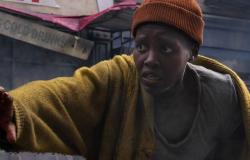A few days ago, Lollapalooza Argentina announced its 10th edition and activated its early ticket sales mechanism, which requires specific cards and exhausting financial engineering for the viewer.
This experience is so much the case that it blurs the hard fact that Lolla was born in the early ’90s and in the United States as an island festival to which the adjective “alternative” was immediately attached. “Alternative”, perhaps something incompatible with the unpleasant task of getting lost in the labyrinth of a ticket booth.
Beyond that, to remember both that big bang and the zigzag development of that adventure surfed by the singer and businessman Perry Farrell is Lolla: The Story of Lollapaloozaa documentary directed by Michael John Warren that reveals the mutations of a monster that already has a transnational character and reached Mumbai.
Available on Flow and Paramount+, in three episodes it reveals everything that one of Generation X had idealized, as well as the contradictions and ups and downs that led the brand to become more associated with millennials and Generation Z.
In other words, in three episodes it goes from the legendary traveling tour intended as a farewell to Jane’s Addiction (Farrell’s band) in 1991 to the current version that has Chicago’s Great Park as its headquarters. And the conversion into mainstreamthe need to recover the initial mystique by being at the forefront of issues naturalized in the progressive agenda of the present, the plateau that led to discontinuing it and the number of bands and soloists who found in Lollapalooza a place of, depending on the case, legitimation, consecration or visibility.
Farrell is the most recurring source and appears in a very The Truman Show, sitting, with a look that includes boots plus a scarf and drinking wine from the spout. And to empower his narrative, Trent Reznor, Tom Morello, Flea and Ice T join in; his first partners (Marc Geiger, Don Muller); and the most current ones from the production company C3 Presents (Charlie Walker, Stacy Rodrigues, Charles Attal), who at the beginning of the century ostracized the festival to give it the consistency it has today.
The episodes of Lolla: The Story of Lollapalooza
The first episode titled F— the Man is the most revealing, even for those who assumed they were sufficiently steeped in Lollapalooza history. In addition to showing how the young Farrell ventured artistically in Los Angeles (he came to the city from New York), that segment reveals that the singer was fed up with Jane’s Addiction (“We really couldn’t stand each other,” he is told. hey) and that I wanted to put an end to the project with a bet inspired by the British Reading festival.
“I only thought about a farewell party for my band,” adds the artist about that founding bet that went from American city to American city with a more than appealing lineup: Ice-T & Body Count, Living Color, Siouxsie and the Banshees, Henry Rollins and NIN.
Here is an interesting first cut, since emphasis is placed on the emergence of the last band listed, the one led by Reznor who showed a squeaky industrial sound and a rabid performance. “They all got their asses kicked,” notes Tom Morello of Rage Against the Machine. “It was a sign that there was a different type of music that could be harder than heavy metal,” adds the violist.
Almost as if accepting the compliment, Reznor points out: “Culturally, something was changing.”
Between fragments of shows and highlights sociocultural performances such as Ice T & Body Count performing Cop Killer, at a time when young African Americans were suffering police repression throughout the United States, the camera returns to Farrell in elegant ways. And he does it so that he remembers that he was happy with what had happened and that he immediately reset absolutely everything to the point of not knowing what he would do the next day.
But he reveals that a call from a potential partner changed everything: “Hey, what if we do it next year?”
Lollapalooza maintained its alternative status in 1992 with Red Hot Chili Peppers, Soundgarden, Ministry, Pearl Jam and Ice Cube, but in subsequent editions it was overwhelmed by the pressure exerted by multinationals to include their artists. That part of the story is embedded in End of the Undergroundthe second episode in which Farrell (already leading Porno For Pyros) confesses to having resisted his partners’ idea of programming Metallica in 1996. For some, the band thrash It was a project with a foundation underground and nihilistic discourse; For the former Jane’s Addiction, on the other hand, he was the visible face of corporate rock.
The press sided with the artist, considering that the festival had acquired elephantine dimensions, incompatible with its countercultural essence. In all of this, Farrell had already shown signs of musical breadth by giving his own last name to an electronic music scene and by creating the conditions to program Tricky, The Prodigy and Orbital, among others.
Surviving Successthe third episode, is perhaps the least attractive in artistic terms, as it focuses on the rescue of Lolla by C3 Presents, which came with the experience of making Austin City Limits, and the appearance of Chicago as the only American venue .
It didn’t happen that the members of this alliance chose an area in that city and settled there. It was necessary to convince vital forces, negotiate with authorities and promise a spill of 500,000 dollars for the city.
Chicago’s Great Park as a base was a successful experience from 2005 to today, with the only interruption of one edition due to a pandemic. And although with this new format it turned decisively towards “entertainment”, the documentary allows us to contrast the respective growths – consecrations of Lady Gaga and Chance The Rapper, for example.
The first one is seen performing in 2007 on a small stage, from which she throws herself at the audience barely dressed in her underwear; and already in 2010, she beamed from the main stage shouting “We did it, little monsters!!!” The second, meanwhile, debuted at the event in 2013 with minimal support to return in 2017 with crew expanded and to pull flow incendiary in front of 100 thousand people.
The story reaches the Billie Eilish phenomenon, although without going into too much depth.
Regarding the expansion of borders outside, meanwhile, Lolla: The Story of Lolla It slightly vindicates the interlocutors that Farrell and C3 Presents met in Santiago, Chile, where the festival landed in 2011. They saw it before us, we must admit.
More information
Lollapalooza 2024, Day 2: A closing of powerful throats, above all things






